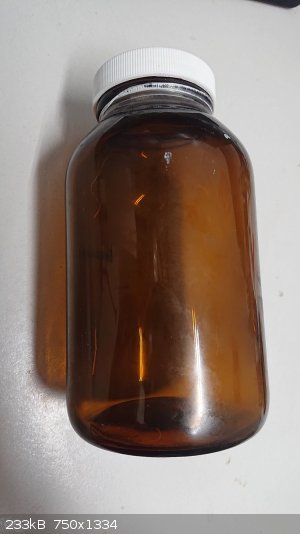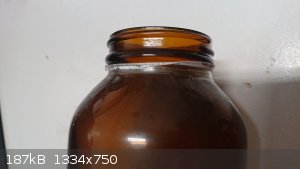CouchHatter
Hazard to Others
  
Posts: 152
Registered: 28-10-2017
Location: Oklahoma
Member Is Offline
Mood: 76 elements taken!
|
|
plastic coated glass
When I was going through some chemical bottles that I obtained secondhand, after I removed a label, I noticed that one of the amber glass bottles is
coated by a thin layer of stretchy plastic. I wonder what this is, and what it might protect against (other than broken glass) - can I put
HNO3 in it, or only HgCl2 and expect it to contain it after the glass is broken? I thought, maybe erroneously, that
"plastic-coated glass" was a hard shell of plastic. Is my bottle a common thing by a different name? It previously held glycerin, so maybe it's just
for cleanup convenience and not safety.
 
|
|
|
CharlieA
National Hazard
   
Posts: 646
Registered: 11-8-2015
Location: Missouri, USA
Member Is Offline
Mood: No Mood
|
|
https://www.usplastic.com/catalog/item.aspx?itemid=32019
These give a better grip and can help contain spills from breakage. I use them for concentrated acids.
|
|
|
Dr.Bob
International Hazard
    
Posts: 2734
Registered: 26-1-2011
Location: USA - NC
Member Is Offline
Mood: No Mood
|
|
These are common for nasty chemicals and material being shipped in certain cases. Some shipping rules require them, some companies just do it as
insurance.
The plastic will only contain the inner material a short time, it serves two purposes, first to hold the bottle together temporarily in case it
breaks, until the material can be transferred, and second, but more importantly, the plastic asks as a protector of the glass, keeping it from
breaking in the first place.
Qorpak sells them (plastric coated) for many sizes of bottles. I have some in 100 ml amber glass bottles with small necks in PTFE lines caps, which
I bought for a "group buy" when several people wanted them. They are only $3 each this way from me. The bottles are fine for acids, organics,
bromine, and others. I have received bromine in the exact same bottle before, as well as TFA.
|
|
|
Eddie Current
Hazard to Self
 
Posts: 78
Registered: 25-7-2018
Member Is Offline
|
|
All of the HgCl2 I have seen has been in plastic containers, which I assume is PE.
http://tools.thermofisher.com/content/sfs/brochures/D20480.p...
I wouldn't keep it in glass for obvious reasons.
|
|
|
Dr.Bob
International Hazard
    
Posts: 2734
Registered: 26-1-2011
Location: USA - NC
Member Is Offline
Mood: No Mood
|
|
BTW, the plastic is likely some sort of plasticized PVC, so not highly chemical resistant, but good for a short time even with organic solvents and
acids. It does tend to sweat plasticizer over time, so the bottles can get sticky or oily feeling over many years. Some of the 4L bottles I have
had with it had a layer of almost 1/4", which likely would hold up a while to most chemicals. You can also buy some pyrex and such coated with the
plastic layer, most commonly in vacuum traps, rotovap receivers and condensers that are under vacuum, and even grad. cylinders, where it helps to
protect them from students, but does make the numbers harder to read.
|
|
|
dawt
Hazard to Self
 
Posts: 74
Registered: 9-5-2016
Location: EU
Member Is Offline
Mood: fluorescent
|
|
You can easily do this yourself. I like dissolving old PVC tubing in THF until it reaches a sirupy consistency. I've been told dissolving 100 g of
polyvinyl butyral in 1-1.5 L EtOH will also do the trick. Just place your glassware on a smooth surface, poor the sirup over it, let dry and you can
easily cut/scrape the excess off and recycle it. You can also easily add more coats if the first one didn't cut it.
|
|
|
CouchHatter
Hazard to Others
  
Posts: 152
Registered: 28-10-2017
Location: Oklahoma
Member Is Offline
Mood: 76 elements taken!
|
|
It's funny you should say that Dr. Bob, it was very sticky! I thought it was residue from some sort of replaced label. I rinsed it three times with
acetone and it only got slightly less sticky. I finally noticed it was coated plastic when I took the lid off.
I don't have any amount of HgCl2 to merit storage in that; I just tried to think of one of the more toxic things I have, if it wouldn't
stand up against common acids. But several seconds resistance is worthwhile for most things!
I'll definitely try making my own if it's that easy! Thank you all for the good information.
|
|
|